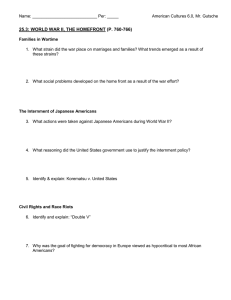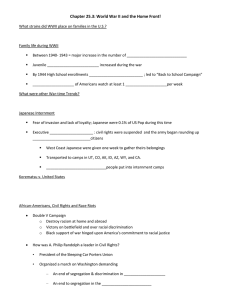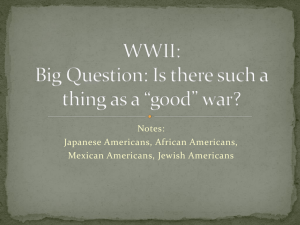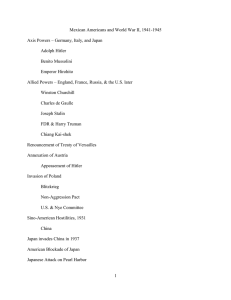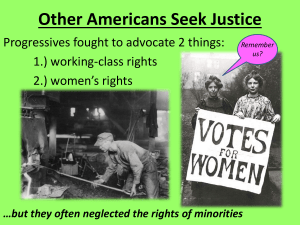The War at Home - Epiphany Catholic School
advertisement
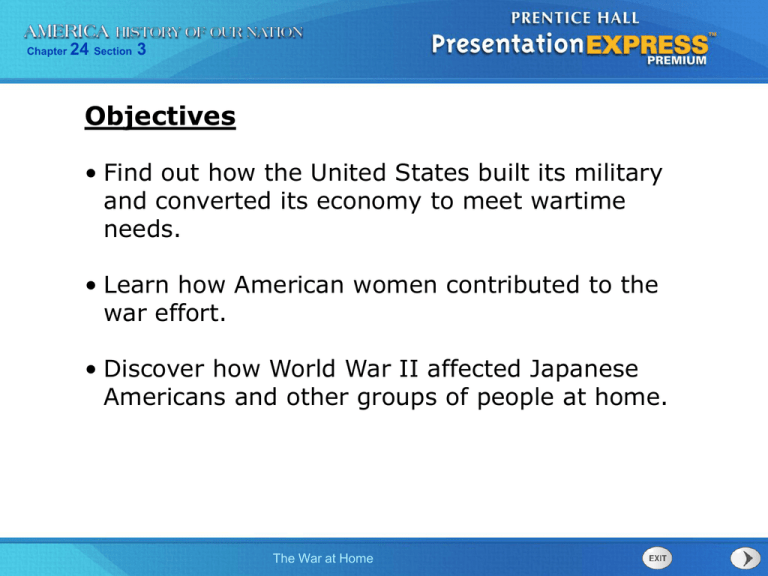
Chapter 24 Section 3 Objectives • Find out how the United States built its military and converted its economy to meet wartime needs. • Learn how American women contributed to the war effort. • Discover how World War II affected Japanese Americans and other groups of people at home. The War at Home Chapter 24 Section 3 Terms and People • rationing – the act of setting limits on the amount of scarce goods people can buy • intern – temporarily imprison • A. Philip Randolph – head of a labor union called the Brotherhood of Sleeping Car Porters • bracero – a Mexican laborer The War at Home Chapter 24 Section 3 How did the home front respond to American participation in the war? World War II involved the people and resources of each nation on a scale that had never been seen before. Americans at home labored in neighborhoods, factories, and fields to help win the war. The War at Home Chapter 24 Section 3 Building the Military The Draft • In 1940, Congress passed a draft law, and just days after the bombing of Pearl Harbor, it revised the law to require people to serve for the entire war. Men Mobilize • More than 15 million American volunteers and draftees served in the armed forces during World War II, including men from every ethnic and religious group. Women Mobilize • Hundreds of thousands of American women served in the armed forces as nurses or in noncombat roles such as the Women’s Army Corps (WACs). • Women pilots ferried bombers from base to base, towed targets, and taught men to fly. The War at Home Chapter 24 Section 3 The government established a War Production Board to supervise industry as it hastily converted its output from consumer to military goods. The war quickly ended the Great Depression, because now there were jobs for everyone, including minorities. The War at Home Chapter 24 Section 3 Americans were expected to help supply Allied forces with food, clothing, and war equipment. Americans planted victory gardens and bought war bonds. To conserve needed resources, the government imposed rationing. These measures boosted the public’s morale by giving citizens at home a sense that they were helping to win the war. The War at Home Chapter 24 Section 3 Defense industries began to recruit women for industry, in order to replace the men who went to war. Women worked in factories and shipyards and became police officers and bus drivers. A fictional character, “Rosie the Riveter,” became a popular symbol of all women who worked for the war effort. The War at Home Chapter 24 Section 3 Because women were needed in industry, they were able to gain better pay and working conditions. The government agreed that women and men should get the same pay for the same job, but some employers found ways to avoid equal pay. Many women gained confidence and independence through their work. The War at Home Chapter 24 Section 3 Treatment of African Americans Segregated Units • As in past wars, African Americans served in segregated units during World War II. • The NAACP and other groups protested against the racial policy of the armed forces and the military nursing corps. Discrimination in Industry • Discrimination was also widespread in industries doing business with the government. • Some African American leaders pointed out that while the nation was fighting for democracy overseas, it still permitted injustice at home. The War at Home Chapter 24 Section 3 Union leader A. Philip Randolph threatened a mass protest unless Roosevelt ended discrimination in the armed forces. Roosevelt ordered employers doing business with the government to support racial equality in hiring. To investigate charges of discrimination, he set up the Fair Employment Practices Committee (FEPC). The War at Home Chapter 24 Section 3 By the end of 1944, about two million African Americans were working in war plants. Americans—black and white—moved to the cities to work in industry. In 1943, race riots broke out in Detroit, New York, and other American cities. Competition for scarce housing led to angry incidents and even violence. The War at Home Chapter 24 Section 3 About 500,000 Mexican Americans served in the armed forces during World War II. Due to the need for workers, in 1942 the U.S. signed a treaty with Mexico that allowed American companies to hire braceros. As more Mexicans moved north to work on farms and railroads, they often faced prejudice and violence. The War at Home Chapter 24 Section 3 Young Mexican Americans in Los Angeles often wore “zoot suits.” In June 1943, bands of sailors on shore leave attacked young Mexican Americans. These incidents sparked several days of rioting. Many blamed the “Zoot Suit Riots” on the Mexican Americans, but the riots were actually the result of prejudice and discrimination. The War at Home Chapter 24 Section 3 During the war, Americans became suspicious of people from Axis countries. Some German and Italian Americans were held in government camps as “enemy aliens.” Most of these were foreign-born residents who had not yet achieved citizenship. The War at Home Other German Americans and Italian Americans faced curfew or travel restrictions. Chapter 24 Section 3 At the start of the war, about 300,000 people of Japanese origin lived in the United States. After the attack on Pearl Harbor, many Americans feared that Japanese Americans would act as spies. However, during World War II, there were no cases of disloyalty by Japanese Americans. Nevertheless, Americans’ intense anti-Japanese fears led President Roosevelt to issue Executive Order 9066 in February 1942. The War at Home Chapter 24 Section 3 The order was used to intern some 110,000 Japanese Americans in small camps for the duration of the war. The War at Home Chapter 24 Section 3 Whole families were rounded up for internment and were allowed to bring only what they could carry. They lived in small, barren camps surrounded by barbed wire. The War at Home Chapter 24 Section 3 Korematsu v. United States The Supreme Court ruled that military necessity justified internment, although three of the justices dissented. When the war ended, the government released the internees. In 1948, it made a small payment to them for the property they had lost. In 1990, the U.S. formally apologized and paid each surviving internee $20,000. The War at Home Chapter 24 Section 3 Despite the unjust treatment, about 17,000 Japanese Americans joined the army. One all-Japanese unit became the most decorated unit in U.S. history. The War at Home Chapter 24 Section 3 Section Review QuickTake Quiz The War at Home Know It, Show It Quiz

